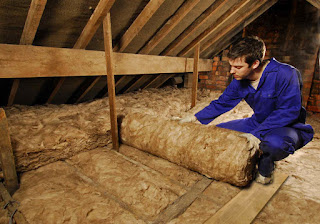The
ceiling is another vital part of the house that should be considered as well in
deciding the places to be insulated. Like all types of insulation, ceiling insulation is a must if you are looking to have a substantial cut in your
energy bills. Among others, it is the most cost-effective energy efficiency
measure you can do.
For
most houses these days that are using cathedral ceiling, or have attic walls
that present unique insulation requirements, a proper insulation installation
is needed to protect the whole house.
Insulating
In the
planning stage and the ensuing installation of the insulation project, you need
to ensure their statuses by checking first. You need to ensure that all the air
lead through the top floor ceiling is sealed completely and thoroughly. Also,
these insulation levels must exceed the local building codes.
There
should also be provision of space for both the insulation and the needed air
flow from the vents at the eaves. The
insulation coverage needs to be continuous.
Likewise,
the area planned for storage should have enough space underneath needed for
insulation purposes. The doors must also be insulated and sealed, with the knee
wall areas having adequate insulation and air sealing barriers.
Techniques
Loose-fill
or batt insulation are typically installed in attics. You need to put the
backing next to the ceiling finish for the batts that has attached vapor
retarders.
The
costs for ceiling insulation vary, which is one of the major reasons for the choices.
However, blown-in loose-fill attic insulation that uses fiberglass, rock wool
or cellulose is usually less expensive than batts. They also give better
insulation coverage.
Loose-fill
The
first task is to seal all attics to home air leaks, especially the chases, bypasses
and the fur downs. Insulation materials like the fiberglass and rock wool do
not necessarily stop the air flow completely.
You
then need to follow up the requirement clearances for heat producing
equipments. These would consist usually of flues or exhaust fans. The other
blocking requirement might be ruled by local building codes.
You
can use metal flashing, plastic or cardboard batt files or pieces of batts or
rigid insulation to do the blocking. To preserve the ventilation, you need to
install rafter baffles for soffit vents in roof eaves. You can use insulation
dams at the soffit, porch, and garage and attic to ensure full coverage.
Insulate
over the attic access using a piece of batt. You also need to get complete
insulation coverage at consistent depths, using rulers, if need be.
Batts
You
need to ensure again that the attic is sealed against air leaks. You also need
to block around heat-producing devices. It is important to cover the top of
ceiling joints or bottom cord of truss with insulation.
You
need to use the complete coverage of full thickness, non-compressed insulation.
When installing the batts, ensure that they completely fill the joist cavities.
Shake them to ensure proper loft. If the joist spacing is not even, pitch the
gaps with scrap pieces.
Do
not compress the insulation with wiring, plumbing or duct work. Ceiling insulation needs proper installation
techniques and care.


